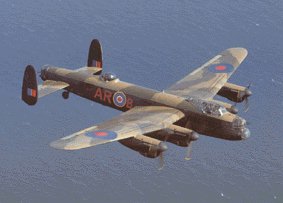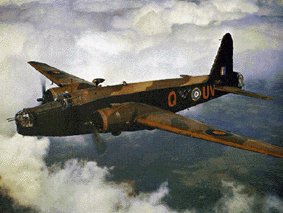
THE AVRO

"WIMPY"
460 Squadron,
R.A.A.F., was equipped with Vickers Wellingtons from March to December,
1942. Squadron crews flew on 76 0perations in these aircraft, raiding targets
in centres such ads Hamburg, Dortmund, Cologne and Wilhelmshaven.
Affectionately
named the "Wimpy" after a cartoon character, the Wellington was a twin
engined bomber that doubled in many roles in Coastal and Training Commands.
The Wimpy
was the only bomber aircraft brought into service before the war began
and was still in service well after the wars end.
Specified
as early as 1932, Vickers produced the first Wellington in 1936. These
aircraft were fitted with Bristol Pegasus engines. Later Rolls Royce Merlins
and Bristol Hercules were used. Over 11,000 were produced before manufacturing
ceased in 1945.
Of Geodetic
Construction (cross membered) developed by Dr. Barnes Wallis of Dambuster
fame, Wimpy was immensely strong. I action it was able to absorb horrific
damage and still remain controllable.
The aircrafts
first operation against the enemy was an attack on German warships at Wilhelmshaven
in 1939 and its last raid was on Previso in Northern Italy in April 1945.
CREW 6
Pilot -- Radio Operator -- Navigator -- Bomb aimer/Nose gunner -- Tail gunner -- Waist gunner
SPECIFICATIONS
2 X Bristol Pegasus XVlll radial engines of 1050 hp each.
Speed 235 mph.
Ceiling 19,000 ft.
Range 1805 miles.
Armament 8 X 0.303 machine guns.
Bomb load 4,500 lb.
Wing span 86 ft.
Length 65 ft.
Controls
were heavy, particularly during an approach to a landing.
Nevertheless, a wonderful
aircraft.
11,000
Wimpys proved it.

THE AVRO
460 Squadron
converted to Lancasters during September 1942.
The Avro
Lancaster was judged to be the most able bomber used during WWll. In 1945
it reached the summit of its effectuality by lifting and delivering a colossal
10 ton "Grand Slam" Earthquake bomb to the German submarine pens in Europe.
Previously unbreachable reinforced concrete was smashed, resulting in large
submarine losses.
Its manoeuvrability
was demonstrated when 617 (Dambuster) Squadron raided the Mohne, Eder and
Scorpe dams. A pilot friendly aircraft that was a pleasure to fly.
All who
flew the Lanc had nothing but praise. Landings were almost "Tiger Mothish",
the aircraft floating along the runway, asking for a perfect three point
landing.
Yet she
was born a failure. Designed by Roy Chadwick for A.V.Rowe Ltd. and called
the Manchester, it was fitted with two Rolls Royce Vulture engines, a new
type that proved to be troublesome. The aircraft could not carry its designed
bomb load and was difficult to fly. Chadwick redesigned the wing and fitted
four Rolls Royce Merlins creating the mighty Lancaster. Of almost 1,000,000
tons of bombs dropped by the R.A.F., the Lancaster carried 610,000 tons.
Bill Spowage.
CREW 7
Pilot -- Radio operator -- Navigator -- Bomb aimer/Nose gunner -- Tail gunner -- Midupper gunner -- Engineer
SPECIFICATIONS
4 X Rolls Royce Merlin engines of 1130 hp each.
Speed 275 mph.
Ceiling 24,500 ft.
Range 2530 miles
Armament 8X 0.303 machine guns.
Bomb load 12,000 lb.
Wing span 102 ft.
Length 59 ft.